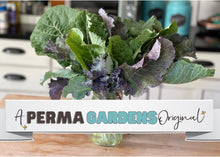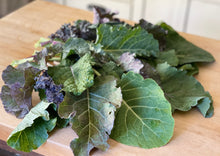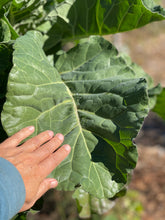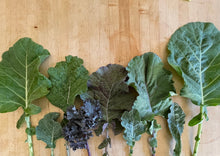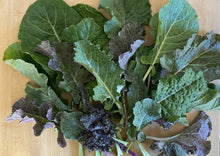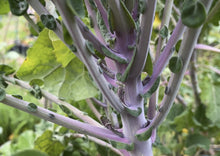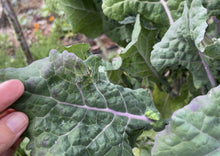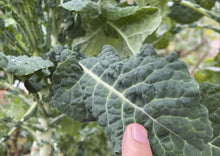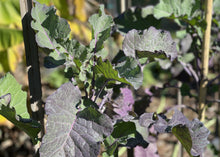
This is the perfect perennial kale & collard mix for those looking for something unexpected! A Perma Gardens Exclusive. Each year we grow out hundreds of perennial kales and collards from seeds we collect from around the world in addition to our homestead favorites. Throughout the growing season, we select for delicious taste, pest resistance, drought tolerance, ease of growth, and beauty. We let only the most amazing plants go to seed and collect these seeds for the next year's trials. In this mix you'll receive the very same seed mix that we will be planting in our garden next season. We call it a buffet because it's a sampling of the best we've got. Get 'em now because when they're out for the season, they're out for good. :) (Brassica oleracea)
*Rooted plants of this variety will be an exact clone of the mother. Seeds will exhibit genetic diversity and you'll see wonderful variations in your plant babies.
Why We Love It
Here are some of the reasons why we love the Brassica Buffet...
1) EXCITING VARIETIES - Every seed packet is a unique sampler platter of colors, textures, and flavors. It's like a garden grab bag! Each seed is genetically unique. In our mixes, we have plants that are blue-toned, some purple-ribbed, some with curly leaves, others flat multi-colored. Big, small, and everything in between. It's an incredible mix for the adventurous gardener.
2) PROLIFIC- Perennial kales and collards are simply one of the best plants for food security. We eat more of these amazing plants than anything else we grow in our food forest. They give us food all year round, and they are at their absolute most delicious when it gets cold out, a time when little else is growing. It's an absolute staple in our meals.
3) GREAT TASTE - We've been selecting kales and collards for lighter flavor, sweeter taste, and for the texture to be more kale-like. They are wonderful chopped up into a stir fry or lightly steamed and used as a wrap. It's really 2 vegetables in one. We like to finely chop up the stems as well as eating the leaves. There's always a vase of perennial kale and collards on our windowsill, waiting for the next meal. It's our Brassica Bouquet.
How to Grow Them
Here's how to grow our Perennial Kales & Collards:
| SUN | FULL SUN |
| MOISTURE | LIKES GARDEN MOISTURE |
| GROWING ZONES | PERENNIAL OUTDOORS IN ZONES 8-10, CUTTINGS CAN BE OVER-WINTERED INDOORS EVERYWHERE ELSE (Not sure? Find your growing zone here) |
| SIZE | 3-6 FEET TALL & 3 FEET WIDE |
| GROWING |
From cuttings: We like to root cuttings in 4" or 1 gallon pots. Fill with moistened potting soil. Simply bury the cutting halfway in the soil. Tamp around the cutting to secure. Water occasionally to keep the soil moist. That's it! They root super easily and you should see new leaves start popping in 4-8 weeks. We root outside year-round in zone 9 and above. If you're colder than this, keep your potted cutting on a window sill until Spring. Let us know if you need any support. We're here for you! From seeds: Start indoor in plug trays 4-6 weeks before last frost date. Seed ¼’’ deep and keep moist. Germ in 7-14 days. Ensure steady moisture and a good light source to reduce stretching, which creates weak stalks. Plant out or pot up once seedling has a strong root structure. From rooted plant: We trim all of the leaves except for the top leaf for shipping to prevent dehydration. Once you plant into moist soil, it will spring to life for you and immediately start growing leaves. It's best not to let your plant flower as it's getting settled into its new home. Trim off any flowers for the first few months. It will seem to grow slowly for the first couple months as the roots settle in, and then it will boom with growth! PRO TIP: The key for this wonderful, branching perennial green is to harvest often! It will allow for optimal air flow, which will keep your perennial kales and collards happy and healthy. If you live in a cooler growing zone, take a branch cutting in the late Fall and pop into a pot and bring indoors for the winter. You can plant out again in the Spring. |
Here are some pruning tips below:
How to Harvest & Use It
Harvest the outer, largest leaves. We suggest harvesting 1/3 or less of the leaves at a time so the plant can continue to gather sun and photosynthesize. In their second year and beyond in warmer climates collard will pop up a flower stalk in the spring. The immature flower buds can be harvested and eaten just like broccoli (it's the same family). While it's flowering, you'll notice that it doesn't make as many leaves. After the plant is finished flowering, cut off the flower stalks and it will increase its leaf production again and give you leaves all summer, fall, and winter.











